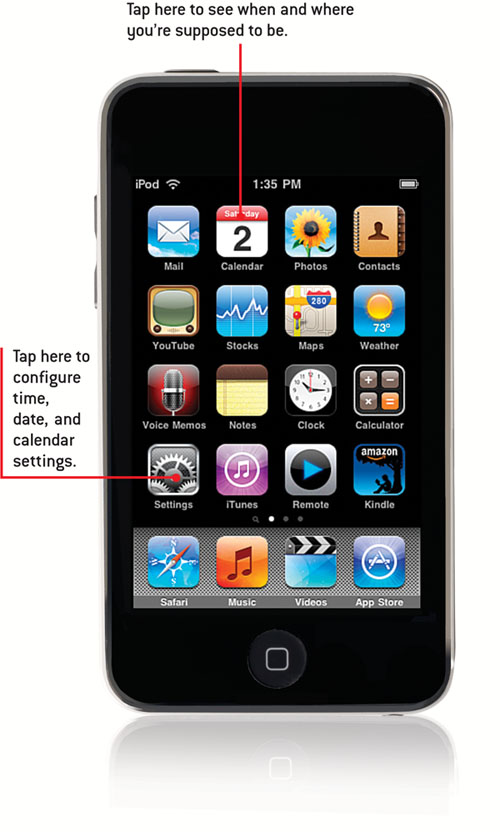
In this chapter, you explore all the time and calendar functionality that an iPod touch has to offer. Topics include the following:
</feature>When it comes to time management, an iPod touch is definitely your friend. Using the iPod touch’s Calendar application, you can view calendars that have been synchronized with your computer’s calendars. Of course, you can also make changes on your iPod touch, and they sync with calendars on your computers so that you have consistent information no matter what device you use. The iPod touch’s handy Clock application provides multiple clocks and alarms.
You should configure a few time, date, and calendar settings before you start using an iPod touch to manage your calendars and time.
On the Home screen, tap Settings.

Tap General.

Scroll down the screen.
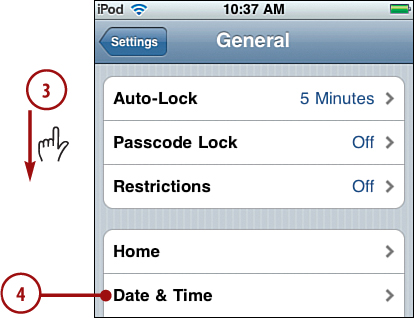
Tap Date & Time.
To have an iPod touch display time on a 24-hour clock, tap the 24-Hour Time OFF button, which becomes ON to show you that an iPod touch is now showing time on a 24-hour scale. To have an iPod touch use a 12-hour clock, tap ON to turn off 24-hour time again.
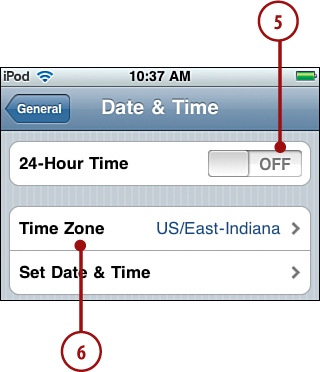
Tap Time Zone.
Type the name of the city that you want to use to set an iPod touch’s time zone. As you type, an iPod touch lists the cities that match your search.
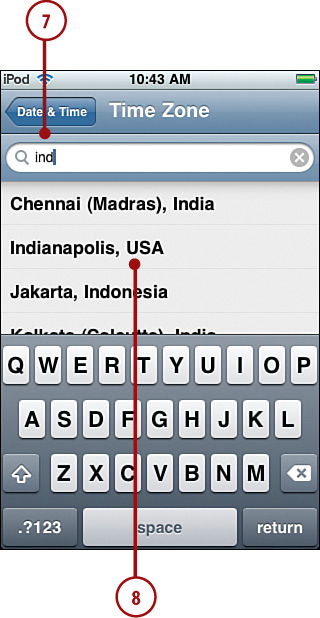
When the city you want to use appears on the list, tap it. You move back to the Date & Time screen, which shows the city you selected in the Time Zone field.
Tap Set Date & Time.

Tap the date button. The date selection wheel appears.
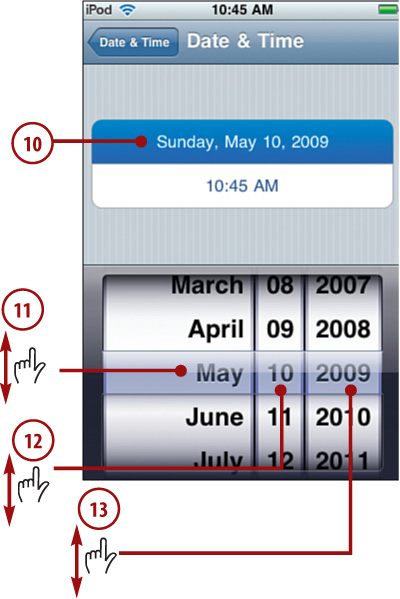
Drag up and down on the month wheel until the center bar shows the month you want to set.
Drag up and down the date wheel until the correct day of the month is shown in the center bar.
Scroll and select the year in the same way.
Tap the time button. The time selection wheel appears.
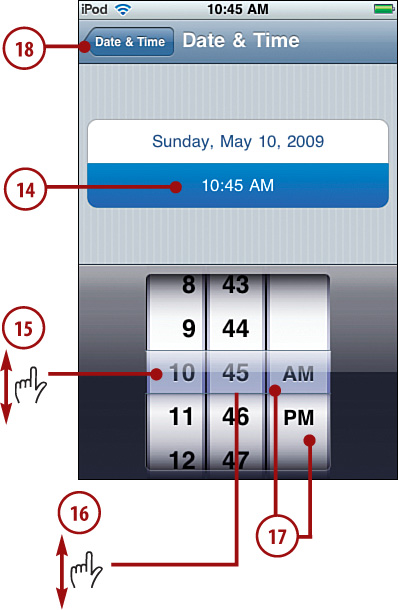
Scroll the hour wheel until the center bar shows the hour you want to set.
Use the minutes wheel to select the minutes you want to set, as shown in the center bar.
Tap AM or PM.
Tap Date & Time.

Tap Settings.

Tap Mail, Contacts, Calendars.
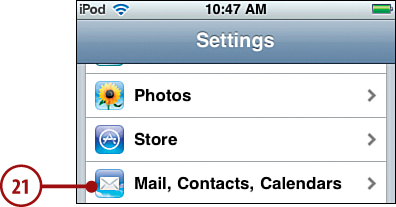
Scroll down until you see the Calendars section.
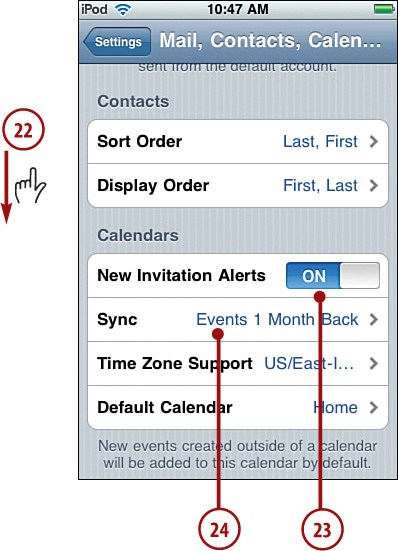
If you don’t want to be alerted when you receive invitations to an event, tap ON next to New Invitation Alerts. Its status becomes OFF to show you that you won’t see these alerts. To be alerted again, tap OFF so the status becomes ON.
To set the period of time over which past events are synced, tap Sync.
Tap the amount of time you want events to be synced; tap All Events to have all events synced, regardless of their age.
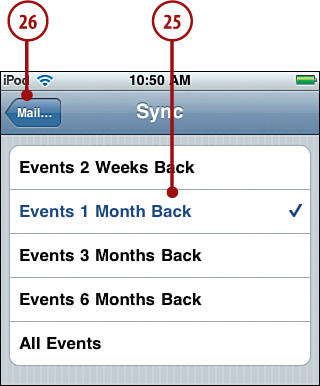
Tap Mail.
Tap Time Zone Support.
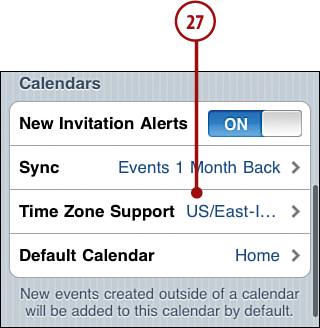
To have your iPod touch display meeting and event times on its calendars based on the iPod touch’s time zone that you set in step 8, tap Time Zone Support ON; it becomes OFF to show you that time zone support is disabled. Skip to step 32.
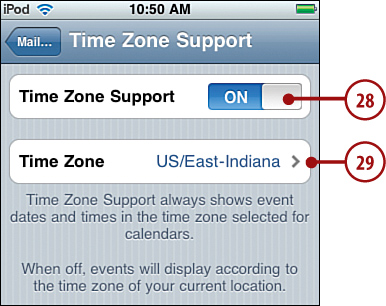
If you leave Time Zone Support ON, tap Time Zone.
Type the name of the city that you want to use to set the time zone. As you type, the iPod touch lists the cities that match your search.
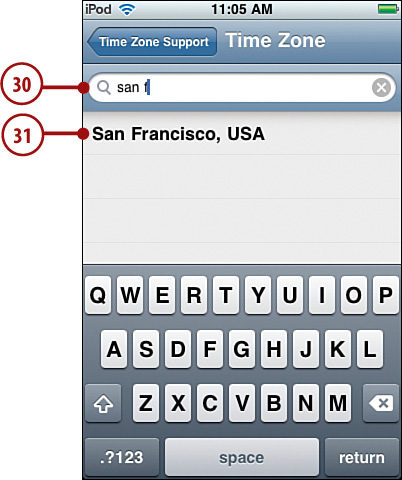
When the city you want to use appears on the list, tap it. You move back to the Time Zone Support screen, and the city you selected is shown.
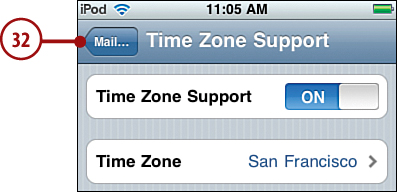
Tap Default Calendar. You see the list of all calendars configured on your iPod touch based on its synch settings and any calendars you have created there.
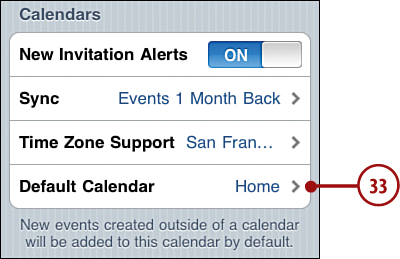
Tap the calendar that you want to be the default, meaning the one that is selected unless you specifically choose a different one.
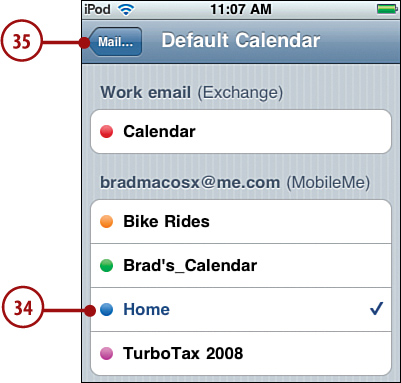
Tap Mail.
Scroll up the screen. To keep your calendar information current, you can configure information to be pushed from where it is managed, such as an Exchange server or MobileMe, onto your iPod touch whenever changes are made.
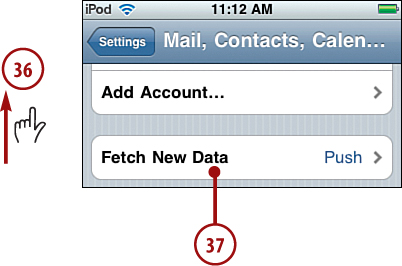
Tap Fetch New Data.
If the status of Push isn’t ON, tap OFF so it becomes ON.
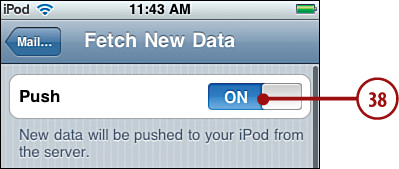
Scroll down until you see the Advanced command.
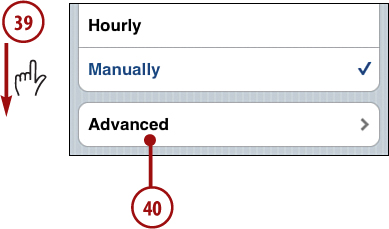
Tap Advanced. You see the list of all your accounts. Under each account, you see the information that is currently being moved to the iPod touch. Along the right edge of the table, you see how the information is being moved, either Push or Manual.
Tap an account from which you are getting calendar information.
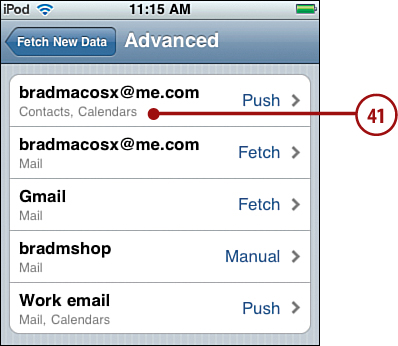
Tap Push to have the account’s information pushed onto an iPod touch or Manual to use the Fetch schedule instead.
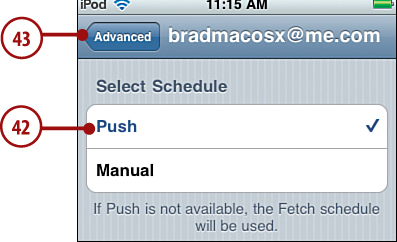
Tap Advanced.
Repeat steps 41 through 43 for each account providing calendar information.
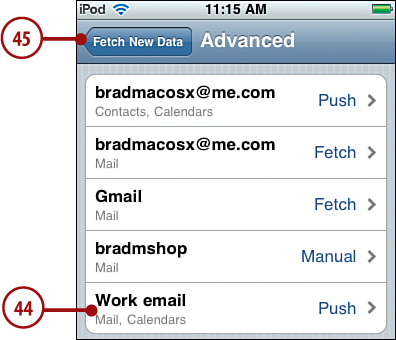
Tap Fetch New Data. Your time, date, and calendar configuration is complete.
An iPod touch can help you manage your calendars. In most cases, you’ll be moving calendar information from a computer onto your iPod touch, but you can add events directly to an iPod touch’s calendar, too. (And when you do, they move to the computer’s calendar the next time it syncs.)
There are a number of ways to sync an iPod touch’s calendar to calendars on your computers. You can use iTunes, MobileMe, or Exchange (Windows Outlook only) to sync calendar information with Outlook (Window PCs) or iCal (Macs). Syncing calendars is covered along with the other information synching options in Chapter 4, “Configuring and Synchronizing Information on an iPod touch.” Before working with your iPod touch’s calendars, use Chapter 4 to set up calendar syncing and then come back here.
You use the Calendar application to view time, and you can choose how you view it, such as by month, week, or day.
On the Home screen, tap Calendar. You return to the most recent calendar screen you were viewing. If that was a specific calendar, you see that calendar. If you were most recently viewing the Calendars screen, you move directly to that screen. If you see the Calendars button in the upper-left corner of the screen, tap it to move to the that screen. If you have only one calendar on your iPod touch, the Calendars screen is hidden, and you always move directly to your calendar; in that case, skip to step 3. On the Calendars screen, you see a list of all your calendars, grouped by account.

Tap the specific calendar you want to view, tap the All accountname (where accountname is the name of the account from which the calendars come) or tap All Calendars at the top of the screen to see all your calendars at the same time.
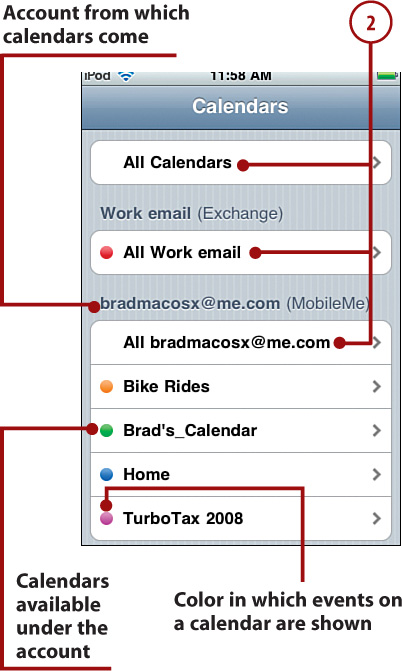
Tap Month. The Month view appears.
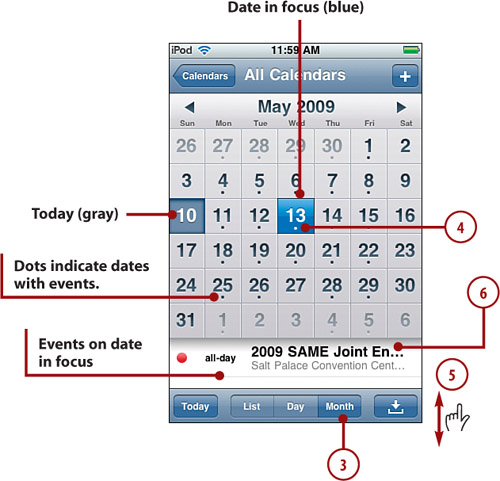
Tap a date in which you are interested. It moves into focus and is highlighted in blue, and the event list shows the events associated with that date.
Scroll the list of events.
To see detailed information for an event, tap it. The Event screen appears.
Read information about the event; scroll down to see all of it if needed.
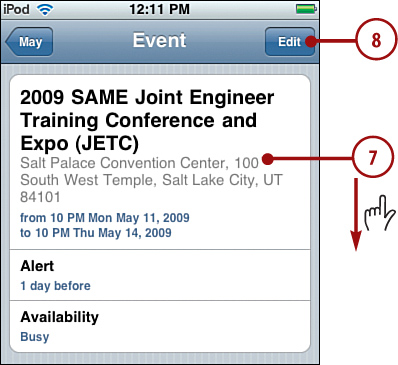
To change the event, tap Edit.
Use the Edit screen to make changes to the event’s information. The edit tools work just like when you create a new event; see Adding Events to the Calendar Manually later in this chapter for the details.
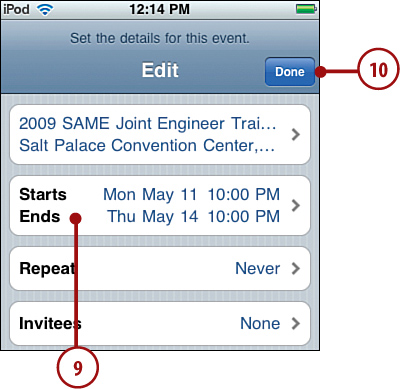
When you finish making changes, tap Done.
Tap the Return button, now labeled with the event’s month. You move back to the Calendar window.
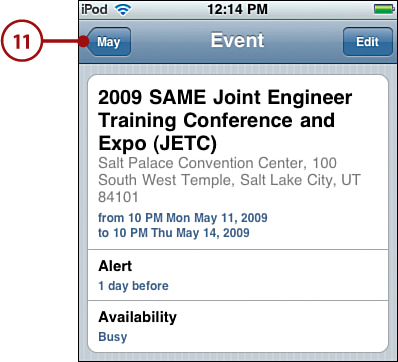
To move ahead to the next month, tap Next.

To move back to the previous month, tap Back.
To move the focus to today, tap Today.
Tap List. The view changes to the List view showing each day in a heading with the events for that day immediately underneath the heading. At the top of the calendar, you see the calendar with which the events are associated.
Scroll the list of dates.

To view or change an event’s details, tap it. The Event screen appears; this screen works just as it does when you access it from the Month view.
Tap Day. The Calendar changes to Day view.
Scroll up and down to see the entire day.
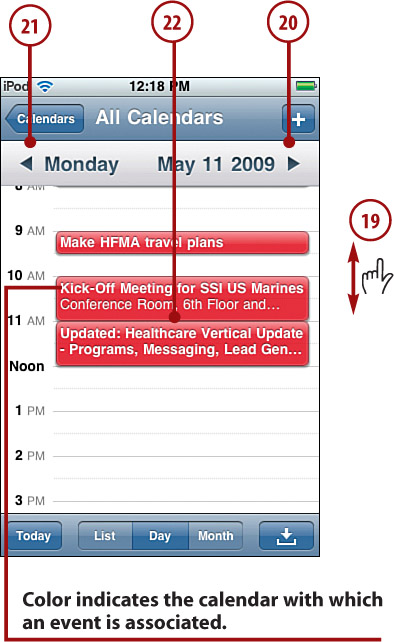
Tap Back to move to the previous day.
Tap Forward to move to the next day.
To view or change an event’s details, tap it. The Event screen appears; this screen works just as it does when you access it from the Month view.
When you are on the move, you can add events to an iPod touch calendar.
View the calendar to which you want to add an event or view All Calendars; you can add events to a calendar in any view.
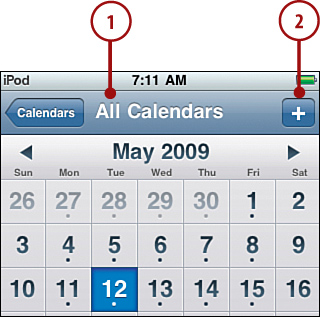
Tap the Add button. The Add Event screen appears.
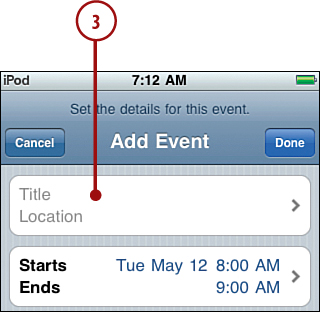
With the cursor in the Title bar, type the title of the event.
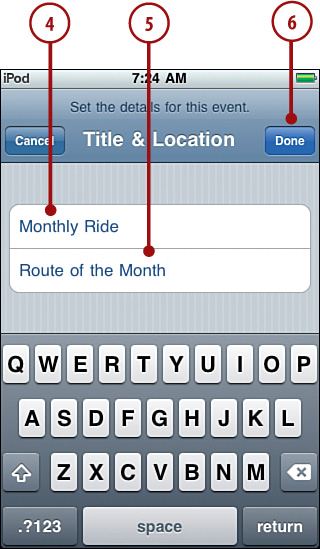
Tap the Location bar and type the location of the event.
Tap Done. You move back to the Add Event screen.
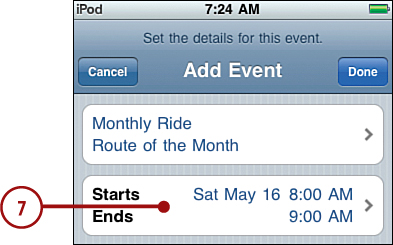
Tap Starts. It is highlighted in blue.
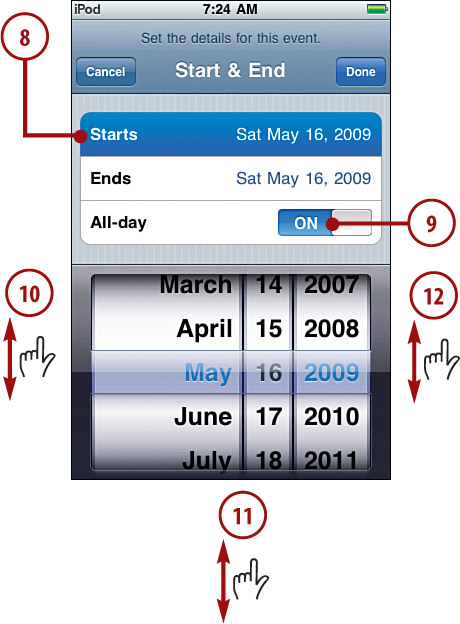
To make the event an all day event, tap All-day OFF; its status becomes ON, and the date selection wheels appear. Follow steps 10 through 16. To set a time for the event, leave the All-day status as OFF and complete steps 17 through 23.
Drag the month wheel until the event’s month is shown in the center bar.
Drag the date wheel to set the event’s date.
Drag the year wheel to set the year in which the event occurs.
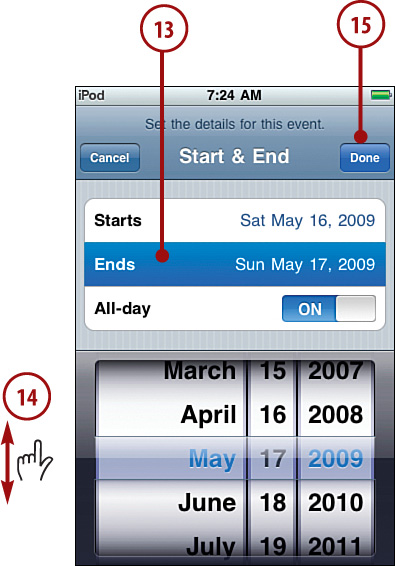
Use the month, date, and year wheels to set the end date for the event.
Tap Done. You return to the Add Event screen, and the event’s dates are set.
Skip to step 24.
Scroll the date wheel until the center bar shows the date of the event.
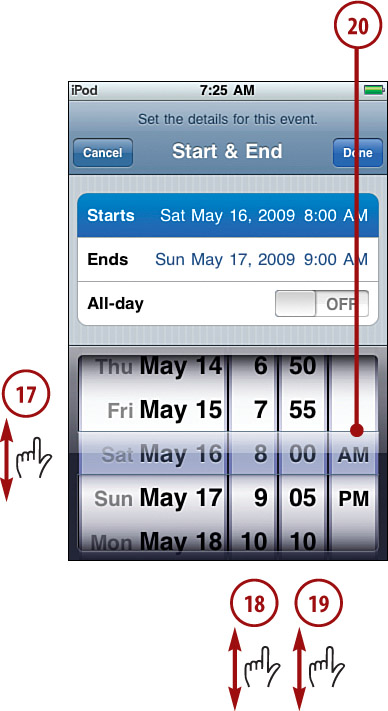
Scroll the hour wheel until the center bar shows the hour the event starts.
Scroll the minute wheel until the center bar shows the minute the event starts.
Tap AM or PM.
Tap Ends. It is highlighted in blue.
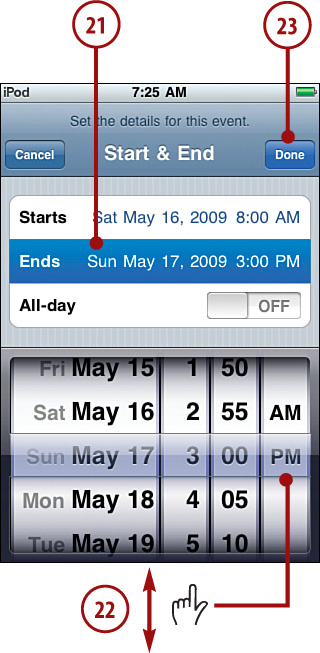
Use the date, hour, and minute wheels and tap AM/PM button to set the end time and date.
Tap Done. You move back to the Add Event screen.
To make the event repeat, tap Repeat and follow steps 25 through 30. (For a nonrepeating event, skip to step 31.) The Repeat Event screen appears.
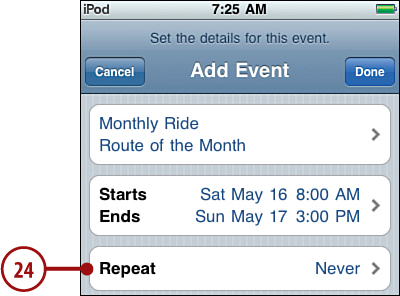
Tap the frequency with which you want the event repeated, such as Every Day, Every Week, and so on.

Tap Done. You move back to the Add Event screen.
Tap End Repeat to set a time at which the event stops repeating, or if you want the event to be repeated forever, skip to step 31.
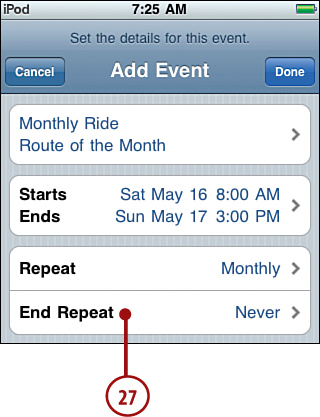
To have the event repeat ad infinitum, tap Repeat Forever and skip to step 30.
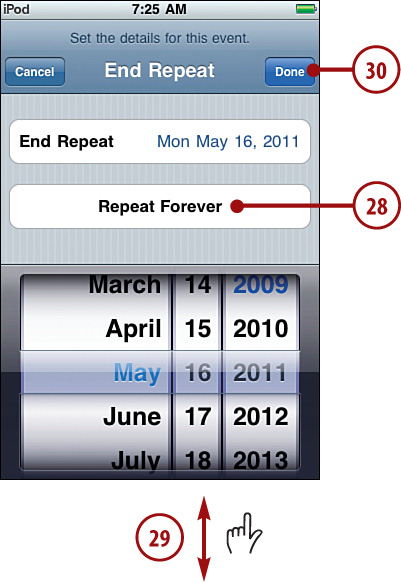
To set an end to the repetition, use the month, date, and year wheels.
Tap Done. You move back to the Add Event screen.
To set an alert for the event, tap Alert. If you don’t want to set an alert, skip to step 37. The Event Alert screen appears.
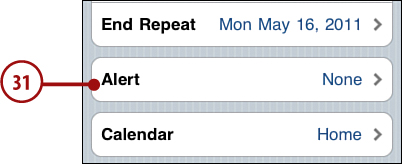
Select when you want to see an alert for the event.
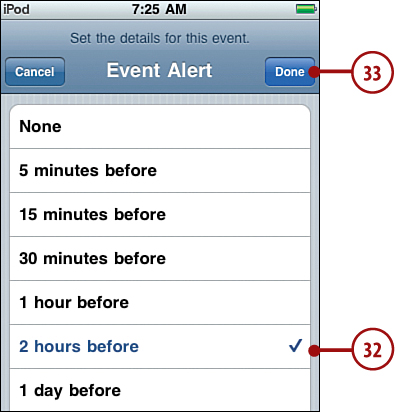
Tap Done. You move back to the Add Event screen.
To set a second alert, tap Second Alert. The Event Alert screen appears.
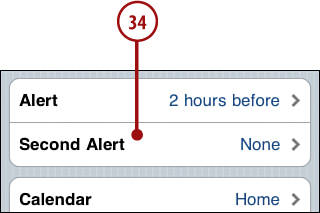
Select when you want to see a second alert for the event.
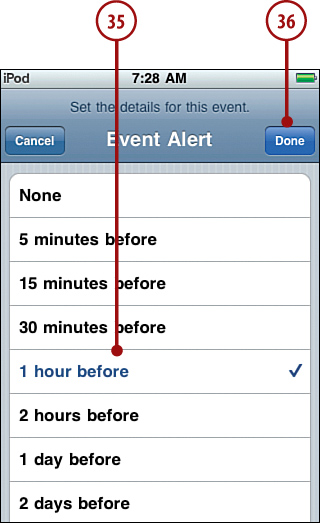
Tap Done. You move back to the Add Event screen.
To change the calendar with which the event is associated, tap Calendar; to leave the current calendar selected, skip to step 40.
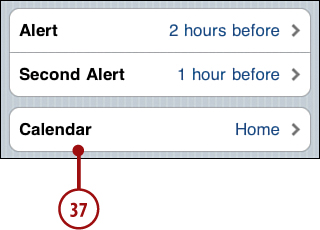
Tap the calendar with which the event should be associated.

Tap Done.
Tap Notes. The Notes screen appears.

Type information you want to associate with the event.
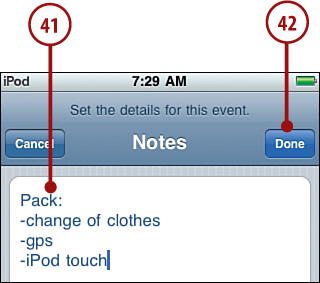
Tap Done. You return to the Add Event screen.
Tap Done. The event is added to the calendar you selected. Any alarms trigger according to your settings.
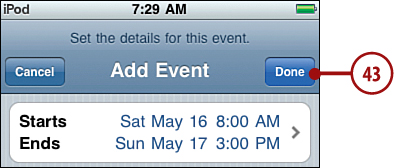
When someone invites you to an event from Outlook via an Exchange account, you receive an invitation notification in the Calendar. You can accept these invitations, at which point the event is added to your calendar, or you can decline the event if you don’t want it added to your calendar.
When you receive an invitation, you see an alert on the screen; tap View to see the details. You move to the Invitations screen.
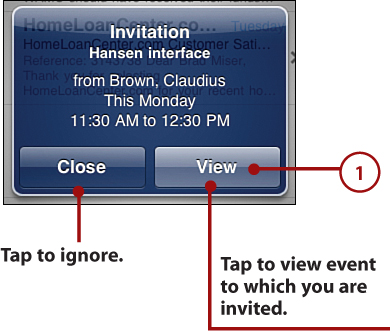
Tap the invitation. You see its Info screen.

Scroll the event to see all of its details.
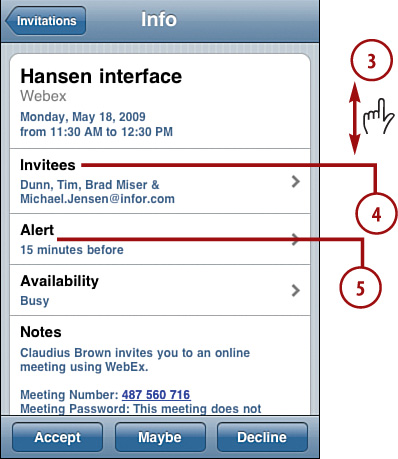
View details about whom the invitation is from and attendees by tapping their areas. You move to detail screens for each.
To configure an alarm for the event, tap Alert and use the resulting Alert screen to choose an alert.
To choose the calendar on which the event should be shown, tap Show in Calendar, and on the resulting screen, tap the appropriate calendar.

To add comments to the event, tap Add Comments and use the Comments screen to enter text about the event.
Indicate what you want to do with the event by tapping Accept, Maybe, or Decline. If you accept the event or tap Maybe, the event is added to the calendar with the status you indicated. If you decline, the event is not placed on a calendar, and the recipient receives a notice that you have declined.
After you make a decision, you move to the Invitations screen, where you see the status of all the invitations you’ve received. Events you’ve accepted or declined appear briefly and then disappear as the appropriate action is taken (such as adding an event you’ve accepted to the calendar).
Tap Done. You move to the calendar; if you accepted or indicated maybe, the event is added to your calendar.
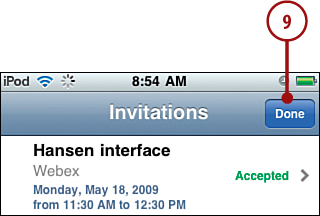
When an event’s alarm goes off, you see an onscreen alert and hear the calendar event sound (if it is enabled). Tap View Event to view details on the Event screen or tap Close to dismiss the alarm.
If the event has a second alarm, it also goes off according to the schedule you set. Handle it the same way as you did the first alarm.

An iPod touch is also useful as an alarm clock, timer, and stop watch. In addition to the primary time you learned to set earlier in the chapter, you can set clocks for a variety of locations.
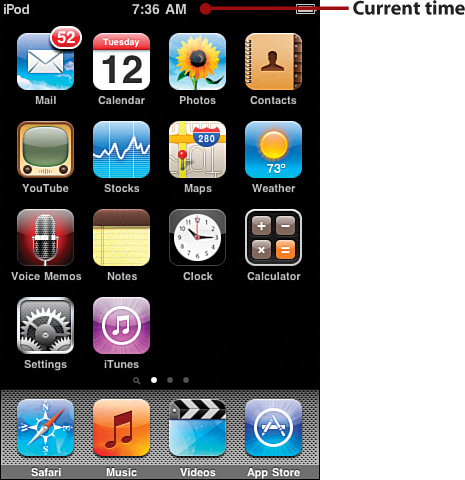
Your iPod touch displays the current time at the top of most of its screens for easy viewing.

When your iPod touch is locked/asleep and you press the Sleep/Wake button or the Home button, it shows the current time and date. If you don’t unlock an iPod touch, it goes to sleep again in a few seconds, making this a very easy way to check the current time without using much battery power.
You can set an iPod touch to display a number of clocks with each clock having a specific time zone associated with it. This makes it possible to know the time in several locations at once. Even better, you can configure multiple alarms to remind you of important events, such as getting out of bed. The Clock also provides a basic but very serviceable stopwatch and timer.
You can create multiple clocks, with each showing the time in a different time zone. If you travel a lot or if you know people in different time zones, this is an easy way to see the time in multiple locations.
On the Home screen, tap Clock. The Clock screen appears.

Tap World Clock. The World Clock screen appears. You see a clock for each location you have configured.
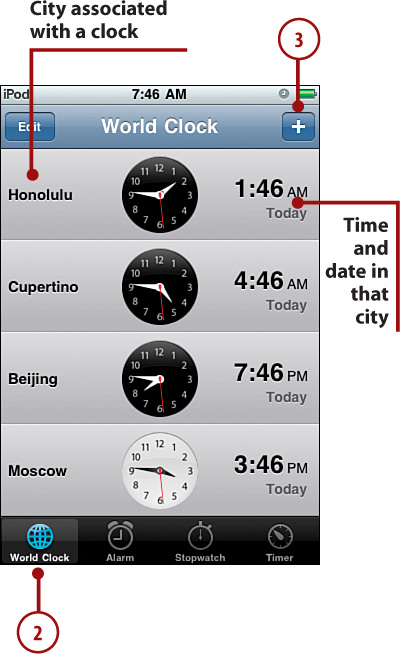
To add a clock, tap the Add button. The Select City screen appears.
Type the name of the city with which the clock is associated; this determines the clock’s time zone. As you type, the iPod touch tries to match cities to what you are typing and presents a list of matching cities to you.
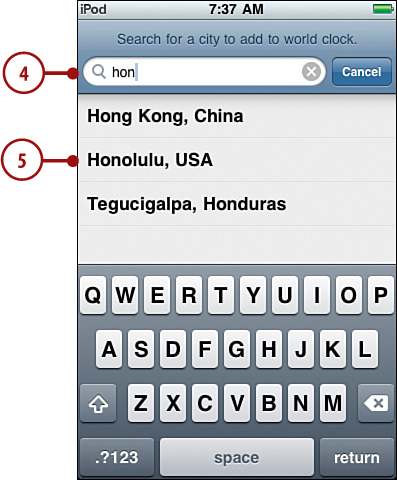
Tap the city you want to associate with the clock. You return to the World Clock screen, and the clock is created, showing the current time in that city.
To remove a clock or to change the order in which they appear on the screen, tap Edit. Unlock buttons appear to the left of each clock.
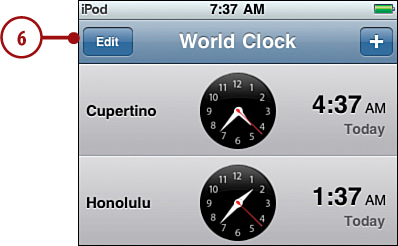
Tap the clock’s Unlock button next to the one you want to delete. The Delete button appears.
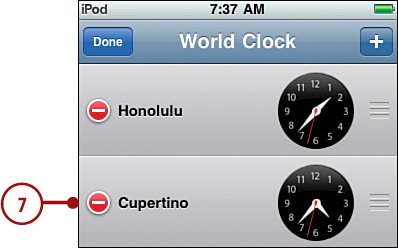
Tap Delete. The clock is deleted.
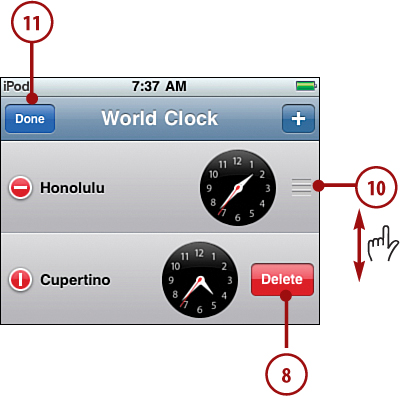
Repeat steps 7 and 8 until you’ve deleted all the clocks you no longer want to see.
Drag clocks up and down the screen by their list icons to reorganize them.
Tap Done.
Your iPod touch is a very handy alarm clock on which you can set and manage multiple alarms.
On the Home screen, tap Clock. The Clock screen appears.

Tap Alarm. The Alarm screen appears. You see the currently set alarms, listed by their times, with the earlier alarms toward the top of the screen.

To add an alarm, tap Add. The Add Alarm screen appears.
To configure the alarm to repeat, tap Repeat; to set a one-time alarm, skip to step 8.
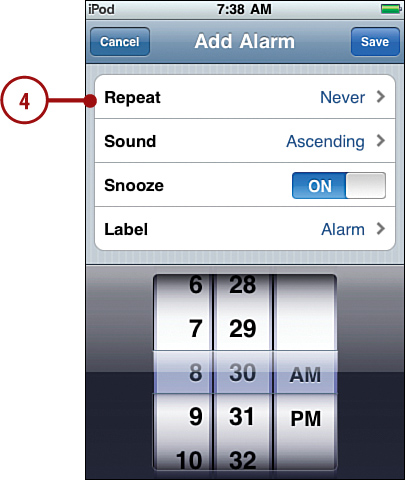
Tap the day of the week on which you want the alarm to repeat. It is marked with a check mark.
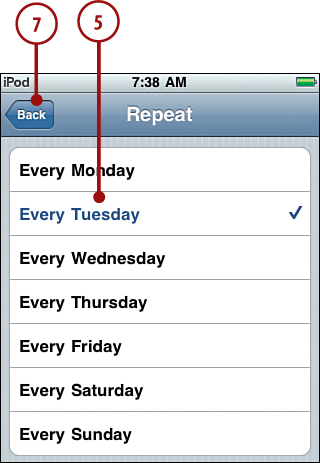
Repeat step 5 as many times as you need. The most frequently an alarm can repeat is once per day.
Tap Back. The Repeat option shows you the days you selected for the alarm to repeat.
To choose the alarm sound, tap Sound. The Sound screen appears.
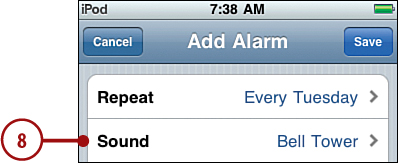
Browse the list of available sounds.
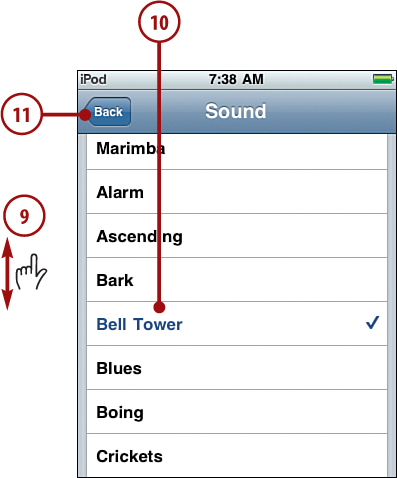
Tap the sound you want to use for the alarm. You hear the sound, and it is marked with a check mark.
After you have selected the sound you want to use, tap Back. You move back to the Add Alarm screen, which now shows the sound that will play when the alarm goes off.
To disable the Snooze function, tap ON. The status becomes OFF. When an alarm sounds and you dismiss it, it won’t appear again. With Snooze set to ON, you can tap Snooze to dismiss the alarm, and it returns at 10-minute increments until you dismiss it.
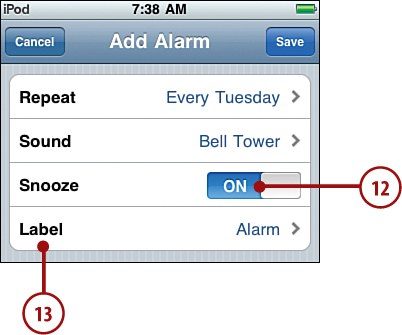
To name the alarm, tap Label. (To leave the default label, which is “Alarm,” skip to step 17.) The Label screen appears. The label is what appears on the screen when the alarm activates, so you might want to give it a meaningful label.
To remove the current label, tap the Clear button.
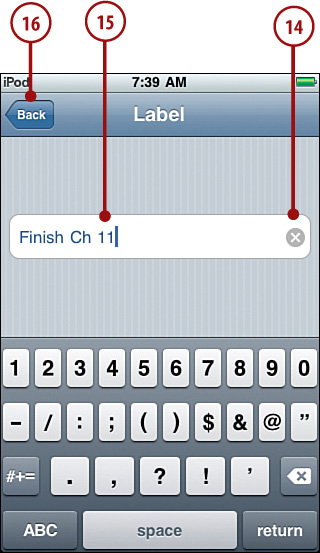
Type a label for the alarm.
Tap Back. You return to the Add Alarm screen, which shows the label you created.
Scroll the hour wheel until you see the hour you want to set in the center bar.
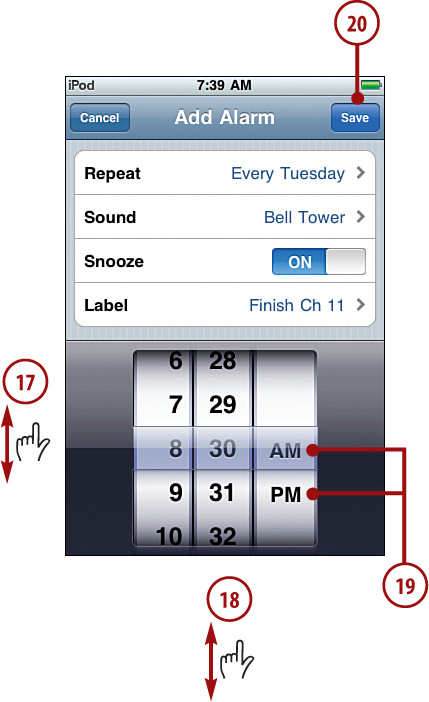
Scroll the minute wheel until you see the minute you want to set in the center bar.
Tap AM or PM.
Tap Save. You return to the Alarm screen, which now shows the new alarm you set. When the appointed time arrives, the alarm sounds and displays on the screen (or just displays on the screen if it is a silent alarm).
You can change existing alarms in several ways.
Move to the Alarm screen.
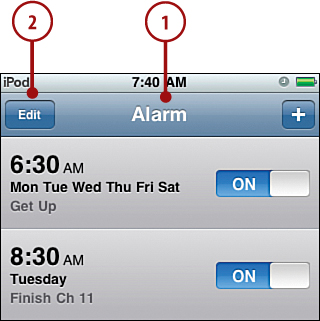
Tap Edit. Unlock buttons appear next to each alarm.
To delete an alarm, tap its Unlock button. The Delete button appears.
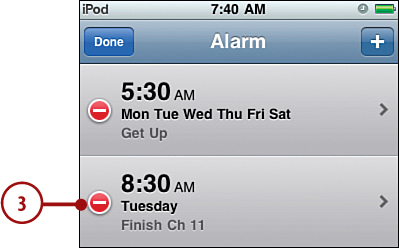
Tap Delete. The alarm is deleted.
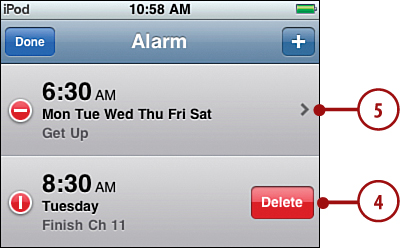
To change an alarm, tap it. The Edit Alarm screen appears.
Use the controls on the Edit Alarm screen to make changes to the alarm. These work just as they do when you create an alarm. (See the preceding task, “Setting and Using Alarms,” for details.)
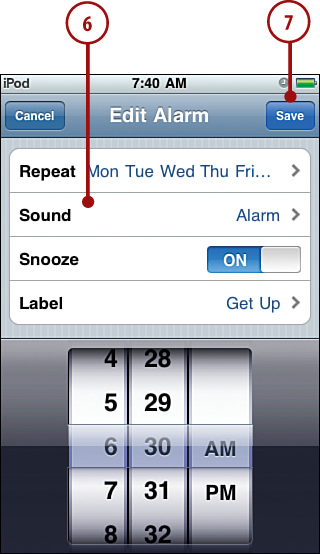
Tap Save. The alarm is changed, and you return to the Alarms screen.
To disable an alarm, tap ON. Its status becomes OFF, and it is no longer active.
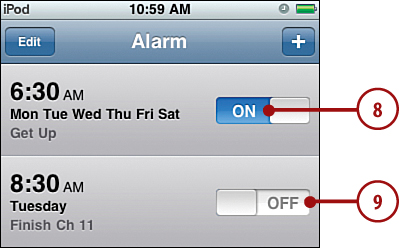
To enable an alarm, tap OFF. Its status becomes ON, and it sounds and appears at the appropriate times.
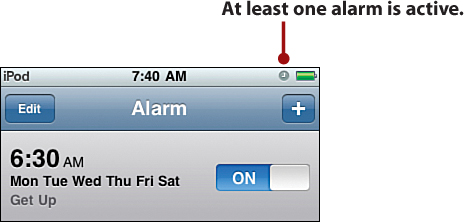
When at least one alarm is active, you see the Alarm Clock icon in the upper-right corner of the screen next to the Battery icon.

When an alarm triggers, you see an onscreen message and hear the sound associated with it. If the alarm is snooze-enabled, tap Snooze to dismiss it; it returns in 10 minutes. To dismiss the alarm, tap OK. You can also dismiss an alarm by pressing the Sleep/Lock button.
